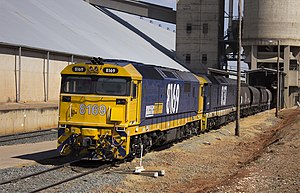New South Wales 81 class locomotive
| New South Wales 81 class | |||||||||||||||||||||||||||||||||||||||||||||||
|---|---|---|---|---|---|---|---|---|---|---|---|---|---|---|---|---|---|---|---|---|---|---|---|---|---|---|---|---|---|---|---|---|---|---|---|---|---|---|---|---|---|---|---|---|---|---|---|
 | |||||||||||||||||||||||||||||||||||||||||||||||
| |||||||||||||||||||||||||||||||||||||||||||||||
| |||||||||||||||||||||||||||||||||||||||||||||||
| |||||||||||||||||||||||||||||||||||||||||||||||
| |||||||||||||||||||||||||||||||||||||||||||||||
The 81 class are a class of diesel locomotives built by Clyde Engineering, Kelso for the State Rail Authority.
History
[edit]Eighty 81 class locomotives were built by Clyde Engineering, Kelso between September 1982 and February 1986, to replace 1950s vintage 42 and 44 class locomotives as well as provide additional capacity. The first 42 were based at Broadmeadow Locomotive Depot to operate Hunter Valley coal trains, while the remaining 38 were mostly employed on the Main South line between Sydney and Albury, hauling both passenger and freight trains.[1] The final 15 were equipped with V/Line radios and, from July 1986, operated through to Melbourne.[2] The 81 class was an evolution of the Australian National AL class, and the V/Line G class and Australian National BL class were, in turn, developed from the 81 class.
In 1991, a further four units were built at Kelso, using many components from spares held.[3] Following the delivery of the 90 class in 1994, the Broadmeadow-based units were released to replace older locomotives on other freight duties. That saw their sphere of operation extended to Brisbane and Broken Hill.[4][5]
In the mid-1990s, some of the later locomotives were leased to National Rail. They were later exchanged for 13 of the earlier locomotives which were permanently transferred to National Rail for use around Australia as high-powered shunters. All were reunited when National Rail and FreightCorp were both sold to form Pacific National in February 2002.
In February 1999, 81s began operating in South Australia, when FreightCorp won a contract to haul brown coal on the Leigh Creek to Stirling North line from Leigh Creek to the Northern Power Station in Port Augusta.[6][7]
As of February 2013[update], Pacific National operated 83, primarily in New South Wales.[8][9] 8147 was written off following a derailment and fire near Forbes on 11 March 2007.
Current Usage
[edit]Pacific National operates the majority of the class in NSW, on a variety of workings such as grain, cement, intermodal and aggregates. 13 members of the class, (8102, 8106, 8107, 8108, 8112, 8114, 8115, 8117, 8118, 8120, 8121, 8122 and 8143) are used in the intermodal division of PN, primarily as yard shunters but occasionally working intermodal trains. Many are assigned to specific yards, for example 8114 and 8122 to the Melbourne Freight Terminal in VIC and 8108 to Adelaide Parklands Terminal in SA.
In November 2023 PN started increasing the usage of 81 class locomotives in Victoria. None have been officially allocated to Victorian workings and are typically transferred to and from Southern NSW to run grain trains South of the border.
Liveries
[edit]All units entered service in the SRA "candy" scheme, later being repainted into the Freight Rail scheme of navy, yellow and white. All units that passed to PN now wear the PN colours of blue and yellow, with a few variations. Intermodal division units 8102, 8108, 8112, 8114, 8115, 8120, 8121 and 8122 have small numbers in blue on the cab sides, rather than the large white numerals on the side of the car body. 8162 has a unique livery (previously also worn by 8103) with both the large and small numbers. Since 2022, 8103, 8130, 8137, 8161 and 8174 have been repainted a second time into PN colours, with white stars on the cab side at one end. 8110 and 8149 also received similar treatment after having had just the cabs repainted. 8130 and 8148 carry "RUOK" stickers on the side of the car body.
References
[edit]- ^ Julian Insall (January 1994). "Exit the Sydney/Melbourne express". Newsrail. Australian Railway Historical Society (Victorian Division). pp. 7–9.
- ^ "V/Line Standard Gauge Report" Railway Digest August 1986 page 247
- ^ "New 81 class locos handed over" Railway Digest August 1991 page 269
- ^ "All Change on the Coast" Railway Digest August 1994 page 38
- ^ "Broken Hill" Railway Digest October 1994 page 34
- ^ "Freight Carriers move into New Markets" Railway Digest January 1999 page 9
- ^ "Ten-Year Leigh Creek Contract for FreightCorp as NSW Flows Lost" Railway Digest October 1999 page 8
- ^ 81 Class Railpage
- ^ 81 Class Vicsig
Further reading
[edit]- New South Wales Rail System Locomotives. Sydney: Archives Section, State Rail Authority of New South Wales. 1984.
External links
[edit]![]() Media related to New South Wales 81 class locomotives at Wikimedia Commons
Media related to New South Wales 81 class locomotives at Wikimedia Commons
